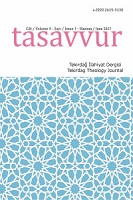Hadis Tenkidinde Arap Dilinin Kullanımı ve İmkanı Bağlamında Bir İnceleme
A Study in the Context of the Usage and Possibility of the Arabic Language as a Method of Hadith Criticism
Author(s): Nilüfer Kalkan YorulmazSubject(s): Language studies, Islam studies, Qur’anic studies
Published by: Tekirdağ Namık Kemal Üniversitesi İlahiyat Fakültesi
Keywords: Hadith; Arabic Language; Hadith Criticism; Textual Criticism; Ghalaṭ; Taṣḥīf;
Summary/Abstract: The issue of textual criticism/matn criticism in the Islamic world has started to be discussed, especially in modern times, when the issue of criticism of the holy books came to the fore in the West. However, when the history of Islamic sciences literature is examined, it is seen that the subject of criticism of hadith texts has been on the agenda of Muslims, even though it is not as central as isnad. One of the important pillars of the text-centered approach as a method of hadith criticism is the Arabic language. In our study, it is aimed to determine the effect and the limits of the Arabic language in hadith criticism based on the text. While doing this, first of all, the discussions about the link between the language and criticism of the holy scriptures in the West will be discussed, and then the relationship between the hadith and the Arabic language will be revealed, especially in the context of istishhād and literature. Then, the place where the Arabic language stands as a method in the criticism of hadith texts will be determined and an evaluation will be made about its limits and possibilities. The evaluations about the limits and possibilities of the Arabic language will be discussed in terms of the narration of hadiths with meaning, the different approaches of linguists and schools, the conflicts between tribes, and the reliability of poetry as an istishhād method. In this study, particular examples obtained by examining Ibn Dureyd’s (d. 321/933) Jamhara al-luga ve Muhammad ibn Ahmad al-Azherī’s (d. 370/980) Tahzīb al-Luga Abū Aḥmad al-ʿAskarī’s (d. 382/992) Taṣḥīfāt al-muḥaddiṯīn and al-Ḫaṭṭābī's (d. 388/998) Iṣlāḥ ġalaṭ al-muḥaddiṯīn and Ṣafadī’s (d. 764/1363) Taṣḥīḥ al-taṣḥīf wa-taḥrīr al-taḥrīf. In addition, the subject has been examined by taking into account other linguistic sources, basic hadith texts and hadith commenta-ries. In this way, the reflection of the subject in the hadith literature will be revealed and it will be tried to determine the place where the Arabic language stands in hadith criticism, taking into account the problems of the language itself.
Journal: Tasavvur Tekirdağ İlahiyat Dergisi
- Issue Year: 9/2023
- Issue No: 1
- Page Range: 579-617
- Page Count: 39
- Language: Turkish

